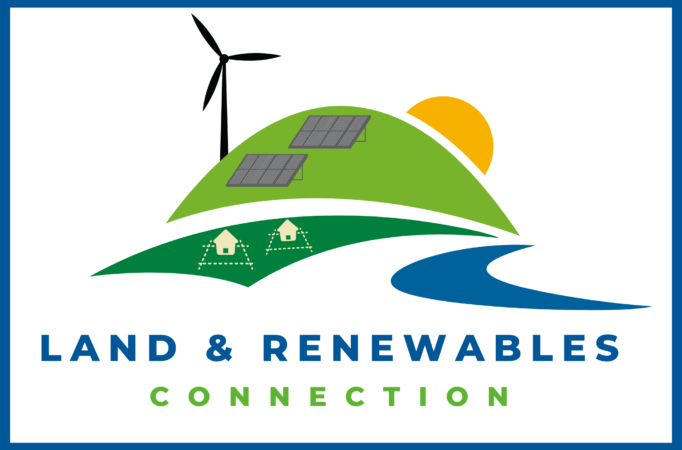Land & Renewables Connection
Is This the Year for Community Solar Legislation in Pennsylvania?
Pennsylvania has no legislation authorizing community solar projects and is one of a small handful of states without any community solar projects. On November 13, 2023, House Bill 1842 was referred to committee in the Pennsylvania House of Representatives for consideration. The purpose of HB 1842 is to provide for community solar facilities. HB 1842 is not the only community solar bill in committee in Pennsylvania General Assembly. Earlier this year, Senate Bill 550 was filed and referred to committee. It was also intended to provide for community solar facilities. So, what is a community solar facility and is the time now ripe for community solar projects in Pennsylvania?
Community solar projects operate at a larger scale than typical roof-mounted solar panels on an individual house or building. A community solar project centers on a larger solar generation facility, like a solar farm. Under the “subscription” model, local individuals and businesses “subscribe” to the project, basically agreeing to buy certain amounts of solar power from the facility. The solar facility generates electricity, which is purchased by the local electrical distribution company, and goes into the power grid. Then, the local electrical distribution company adjusts the power bills of the community solar project subscribers to reflect their attributed amount of energy from the community solar project at the per-unit generation cost of the solar power. In theory, the generation costs from the community solar project should be cheaper than the electricity generation costs from other sources. There is also an “ownership” model for a community solar project that involves individuals and businesses actually buying part of the solar generating project itself. That involves a different cost structure but allows owners the potential to participate in tax credits and incentives not available in subscription models.
By adding more clean, low-cost power inputs into the electrical grid, community solar projects can be beneficial. They also allow individuals and businesses to participate in the low cost of solar energy power without the big up-front costs of installing solar panels on the roof. However, there are also issues with community solar. One of those issues is the necessary transparency so that subscribers are informed about what they are purchasing when they enter into contracts to be part of a community solar project. Likewise, the larger scale of community solar projects has land use implications and can potentially take away impact prime agricultural land, creating friction with other present legislative priorities.
As the co-sponsorship memoranda associated with Pennsylvania House Bill 1842 and Senate Bill 550 suggest, there is a desire among some legislators that Pennsylvanai does not have ground rules for community solar projects. Given the “blank slate” for community solar projects in Pennsylvania, House Bill 1842 attempts to provide a baseline framework for the concept and how it could operate in the Commonwealth to get things off the ground.
The House Bill provides a reasonably detailed definition of a "Community solar facility" as “[a] facility that meets all of the following criteria:
(1) Is located within this Commonwealth.
(2) Is connected to and delivers electricity to a distribution system operated by an electric distribution company operating in this Commonwealth and in compliance with requirements under this act.
(3) Generates electricity by means of a solar photovoltaic device with a nameplate capacity rating that does not exceed:
(i) 5,000 kilowatts of alternating current for a facility that is not a brownfield or rooftop community solar facility; and
(ii) 20,000 kilowatts of alternating current for a facility that is not a brownfield or rooftop community solar facility.
(4) Has no single subscriber who subscribes to more than 50% of the facility capacity in kilowatts or output in kilowatt hours, except for a master-metered multifamily residential and commercial building.
(5) No less than 50% of the facility capacity is subscribed by subscriptions of 25 kilowatts or less.
(6) Credits some or all of the facility-generated electricity to the bills of subscribers.
(7) May be located remotely from a subscriber's premises and is not required to provide energy to on-site load.
(8) Is owned or operated by a community solar organization.
The proposed legislation also inclusively defines a "Subscriber" to be “[a]n electric distribution customer of an electric distribution company who contracts for a subscription of a community solar facility interconnected with the customer's electric distribution company. The term includes an electric distribution customer who owns a portion of a community solar facility.” That definition includes both a subscription model and an ownership model of community solar. HB 1849 contains details regarding how the application of credits to subscribers’ bills, disclosures to subscribers and consumer protection available to potential subscribers to community solar projects. Additionally, it addresses some mechanics of interconnection into the electric grid and sales of electricity generated from the projects.
Given that Pennsylvania presently has no community solar projects, proposed legislation like HB 1849 and SB 550 could reasonably function as starting points to establish a framework for an economic activity that does not presently exist. That, conceptually, seems a better approach than legislating after the horse has already left the proverbial barn, as occurred with Pennsylvania’s oil and gas boom over the past few decades.
One interesting component of HB 1849 is the attempted differential treatment between community solar generated via rooftop community solar facility or a brownfield community solar facility. HB 1849 appears to have a “typo” in this regard, as it states in its definition of a “community solar facility” that it:
(3) Generates electricity by means of a solar photovoltaic device with a nameplate capacity rating that does not exceed:
(i) 5,000 kilowatts of alternating current for a facility that is not a brownfield or rooftop community solar facility; and
(ii) 20,000 kilowatts of alternating current for a facility that is not a brownfield or rooftop community solar facility.
(emphasis added). In other words, as written, there is no differentiation between these generation locations. The companion bill, SB 550, has these same nameplate capacities, but allows the higher nameplate capacity for generation on brownfields or rooftop community solar facilities. That strongly suggests a drafting error here in HB 1849. Assuming that is the case, and that the intent is that more than a single solar photovoltaic device could be installed as part of a community solar project, the allowance of higher capacity community solar facilities on brownfield sites and rooftops seems beneficial from a public policy perspective. Pennsylvania has lots of roofs and lots of brownfield sites that could benefit from productive economic use. It is reasonable to prioritize those locations over lands that could be maintained for agriculture or used for other economic activities.
Time will tell if this is the year (or legislative session) for community solar in Pennsylvania. But, regardless of what happens with HB 1849 or SB 550, momentum seems to be gathering behind community solar legislation in the Commonwealth. While community solar projects can offer benefits, they also involve land use and property issues and contractual agreements with sophisticated companies. Houston Harbaugh’s renewable energy, zoning and land use attorneys are uniquely positioned to assist clients with such matters. If you have a question regarding renewable energy, zoning and property/land use issues, contact attorney Brendan A. O’Donnell at 412-288-2226 or odonnellba@hh-law.com
About Us
These are cutting edge legal issues. The law of the future. Renewable energy, zoning and land use issues will shape the future of growth in the region. Houston Harbaugh’s Renewable Energy, Zoning and Land Use practice focuses on assisting clients maximize and protect the value of their properties, whether related to renewable energy, commercial or residential development opportunities.
As renewable energy becomes more reliable, efficient, inexpensive and technologies associated with carbon capture and storage advance, Pennsylvania, West Virginia and Ohio are in position to benefit from these two parallel energy development opportunities. The region’s geographic location and existing infrastructure presents unique opportunities for property owners to participate in solar, wind, geothermal, other renewable energy developments, as well as for carbon capture, carbon sequestration and carbon storage projects. Additionally, legacy oil, gas and coal infrastructure may be repurposed and reused in connection with new energy developments.
With any development, whether renewable energy, commercial or residential, there are a host of zoning and land use issues that directly impact the most basic parts of daily life of both individuals and communities. Determining where and how land can be developed impacts property ownership, property value, quality of life and the economic development and wellbeing of communities. Zoning and land use issues are, on one hand, matters of local concern but, on the other hand, potentially subject to county or state regulations.
The Renewable Energy, Zoning and Land Use practice draws on Houston Harbaugh attorneys’ experience in energy, oil and gas and real property matters to advance clients’ interests in both transactional and litigation matters. Houston Harbaugh’s Renewable Energy, Zoning and Land Use attorneys assist clients with matters including:
- Solar energy leases;
- Wind energy leases;
- Pore space ownership for carbon capture / carbon sequestration / carbon storage, geothermal and waste disposal;
- Ownership of legacy oil, gas and coal infrastructure for repurposing/renewable energy usage;
- Compliance with existing solar, wind and renewable energy leases;
- Surface and subsurface accommodation between competing land uses;
- Variance, Special Exception and Conditional Uses applications/hearings;
- Land use appeals;
- Eminent domain

Brendan A. O'Donnell
An attorney in Houston Harbaugh’s Oil and Gas Practice, Brendan O’Donnell has represented oil and gas owners across Pennsylvania in a wide array of oil and gas matters for over a decade. This experience has involved not only the Marcellus shale and the Utica shale, but more traditional oil and gas development as well.
Brendan maintains a diverse practice, representing clients in all matters involving oil and gas spanning the transactional and litigation realms. On the transactional front, Brendan routinely assists landowners with negotiating oil and gas leases, pipeline rights of way and surface use agreements and subsurface easements related to horizontal drilling as part of Marcellus and Utica shale development. Brendan also frequently reviews royalty statements and oil and gas ownership issues as well as preparing deeds and title curative documents. Brendan also maintains an active litigation practice, representing clients in state and federal courts, as well as private arbitration matters. This litigation often involves title disputes, pooling and unitization challenges, lease termination questions and royalty/ post-production cost claims.
Assisting clients across the spectrum from contract negotiations through litigation and appeals gives Brendan valuable first-hand knowledge about how oil and gas agreements are prepared, how disputes arise and how courts resolve these issues. Brendan stays up-to-date on developments in oil and gas law and writes frequently on the these topics. Additionally, as alternative energy generation like wind and solar are increasingly being developed in oil and gas producing regions, Brendan assists clients with navigating the interplay between these complex energy developments and evaluating solar agreements.
Brendan complements his oil and gas practice by representing property owners, including oil and gas owners, in zoning and land use matters. Brendan has represented clients before municipal bodies and in appeals to court. Brendan is also active in the firm’s Energy and Environmental Law Practice.
Regardless of the type of representation, Brendan prides himself in providing clients with realistic, pragmatic advice. Hiring an attorney is an investment and Brendan focuses on how he can provide value to clients.
Outside of the office, Brendan serves on the Town of McCandless Planning Commission and lives with his family in McCandless. Brendan has visited every one of Allegheny County’s 130 municipalities.

